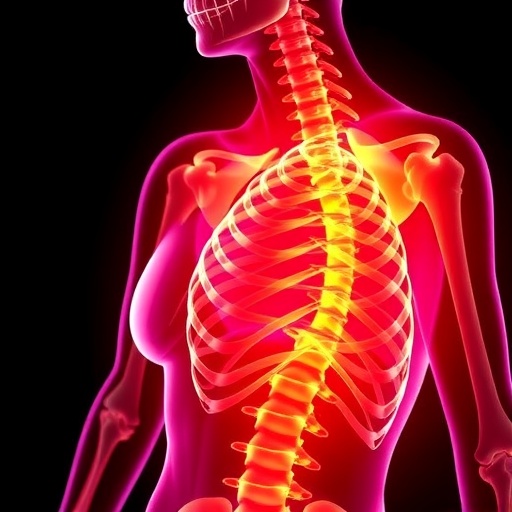A groundbreaking joint position statement was recently published, offering an updated roadmap for managing aromatase inhibitor-associated bone loss (AIBL) in women undergoing endocrine therapy for hormone-sensitive breast cancer. This comprehensive update, authored by an international consortium of experts, underscores the significant skeletal risks presented by aromatase inhibitors (AIs), a mainstay in breast cancer treatment, and provides much-needed clarity on assessing and mitigating fracture risk in this vulnerable population.
Aromatase inhibitors have transformed the therapeutic landscape for postmenopausal women with estrogen receptor-positive breast cancer, dramatically lowering the likelihood of disease recurrence. Yet, their efficacy comes at a cost: these agents inhibit peripheral estrogen synthesis, which, while suppressing tumor growth, inadvertently accelerates bone resorption. The resulting imbalance in bone remodeling predisposes women to osteoporosis and fractures, complications that can severely impact quality of life and long-term survival outcomes.
The updated statement emerges from a collaborative effort bridging expertise from leading organizations including the International Osteoporosis Foundation (IOF), the Cancer and Bone Society (CABS), and the European Calcified Tissue Society (ECTS), among others. By integrating data from recent clinical trials, meta-analyses, and systematic reviews published since the initial 2017 recommendations, this document establishes a rigorous, evidence-based framework tailored for clinicians navigating AIBL management.
At its core, the statement advances fracture risk stratification. Utilizing a multifactorial approach, the updated guidance emphasizes refined algorithms that incorporate not only bone mineral density (BMD) but also clinical risk factors, duration of AI therapy, previous fracture history, and emerging biomarkers of bone turnover. This nuanced stratification enables personalized risk evaluation, allowing for more targeted intervention before irreversible bone damage occurs.
An important focus of the statement is the consideration of extended AI therapy beyond five years, a clinical scenario becoming increasingly common due to evidence supporting longer adjuvant endocrine treatments. The new data highlight a progressive cumulative detrimental effect on bone integrity with prolonged AI exposure, necessitating vigilant monitoring protocols and timely initiation of bone-protective measures.
Pharmacologic strategies remain central to mitigating AI-induced bone loss. The statement updates recommendations on the use of antiresorptive agents such as bisphosphonates and denosumab, with detailed guidance on initiation timing, dosing regimens, and duration of therapy in the context of cancer treatment. Notably, recent trial evidence on the dual benefits of certain agents in both fracture prevention and potential anti-tumor effects informs these recommendations, fostering an integrative approach to care.
Moreover, the joint statement delves into emerging insights on the interplay between bone-targeted therapies and oncologic outcomes. Beyond protecting skeletal health, these treatments may influence breast cancer progression by modulating the bone microenvironment, potentially reducing bone metastases and impacting overall survival. Such findings underscore the necessity for interdisciplinary collaboration in managing patients holistically.
Professor Peyman Hadji, who led the consensus writing group, emphasized the clinical imperative: “Aromatase inhibitors’ detrimental effects on bone represent a significant clinical challenge. Our updated position statement strives to provide practical, evidence-based guidance, ensuring that bone health receives as much attention as cancer control in the management of postmenopausal women.” This balanced perspective advocates that bone preservation is not ancillary but integral to optimizing patient outcomes.
Complementing this view, Professor Nicholas Harvey highlighted the educational dimension required for effective fracture prevention. He advocated for transparent communication with patients, stating, “Every woman prescribed aromatase inhibitors must be informed about her increased fracture risk. Empowering patients with knowledge and shared decision-making tools is essential to implementing prevention strategies successfully.”
The publication’s timing is especially relevant as the field moves towards personalized oncology, with treatments tailored not only to tumor biology but also to individual comorbidities. The updated algorithm offered synthesizes complex clinical variables into accessible decision pathways, facilitating adoption in both oncology and osteoporosis care settings worldwide.
Importantly, this position statement recognizes the diversity of patients impacted by AIBL, encompassing geriatric populations who may be especially susceptible to fractures and treatment complications. The involvement of the International Society for Geriatric Oncology (SIOG) reflects an awareness of age-related considerations and the need for therapy adjustments to balance efficacy and safety in older adults.
Finally, the statement serves as a call to action, encouraging multidisciplinary teams to incorporate systematic bone health assessment into routine oncology workflows. Through proactive screening, tailored pharmacotherapy, and ongoing monitoring, the dual goals of effective cancer therapy and maintenance of skeletal integrity can be met, ultimately reducing morbidity and improving survivorship quality.
This pivotal update consolidates current understanding and provides a robust clinical toolkit to confront the challenges of AIBL. As both oncologists and osteoporosis specialists adopt these recommendations, a new standard of care is poised to emerge—one that seamlessly integrates cancer control with preservation of bone health, reflecting the best of precision medicine and patient-centered practice.
Subject of Research: People
Article Title: Management of aromatase inhibitor-associated bone loss (AIBL) in women with hormone-sensitive breast cancer: An updated joint position statement of the IOF, CABS, ECTS, IEG, ESCEO, IMS, and SIOG
News Publication Date: 11-Jun-2025
Web References:
– www.osteoporosis.foundation
– www.capturethefracture.org
– www.worldosteoporosisday.org
– www.buildbetterbones.org
References:
Hadji, P., Aapro, M., Al-Dagri, N., Alokail, M., Biver, E., Body, J. J., Brandi, M. L., Brown, J., Confavreux, C., Cortet, B., Drake, M., Ebeling, P., Eriksen, E. F., Fuleihan, G. E., Guise, T. A., Harvey, N. C., Kurth, A., Langdahl, B., Lems, W., Matijevic, R., McCloskey, E., Nappi, R., Palacios, S., Pfeiler, G., Reginster, J. Y., Rizzoli, R., Santini, D., Tuzun, S., Van Poznak, C., Villiers, T., Zillikens, M. C., & Coleman, R. (2025). Management of aromatase inhibitor-associated bone loss (AIBL) in women with hormone-sensitive breast cancer: An updated joint position statement of the IOF, CABS, ECTS, IEG, ESCEO, IMS, and SIOG. Journal of Bone Oncology, 53, 100694.
Keywords:
Osteoporosis; Aromatase inhibitors; Breast cancer; Bone loss; Endocrine therapy; Fracture risk; Bone metastasis; Antiresorptive therapy; Postmenopausal women; Oncology; Bone health; Precision medicine




